[ad_1]
At first blush, the Romanian deadlift looks like a lazy or downright dangerous version of the regular deadlift.
Ironically, it’s not a one-way ticket to snap city, but one of the single best exercises you can do for developing your hamstrings, glutes, spinal erectors, lats, and even your forearms.
It’s also easy to learn, load, and program, and when it’s performed correctly, it’s also perfectly safe.
In this article, you’ll learn what the Romanian deadlift is, which muscles it works, the benefits of the Romanian deadlift, how to Romanian deadlift with proper form, the best Romanian deadlift alternatives, and more.
What Is a Romanian Deadlift?
The Romanian deadlift, also known as the “RDL” or “barbell Romanian deadlift,” is a lower-body exercise that’s similar to the conventional deadlift, but it targets your hamstrings and glutes more than your back.
It got its name in 1990 when a Romanian Olympic weightlifter named Nicu Vlad was in San Francisco demonstrating an exercise that looked like a cross between a stiff-leg and conventional deadlift.
Someone in the audience asked what it was called. He shrugged and said it was just something he did to strengthen his back. The U.S. Olympic weightlifting coach was there and suggested they call it the Romanian deadlift, and the rest is history.
Romanian Deadlift vs. Deadlift
The Romanian deadlift and the conventional deadlift are similar exercises that train similar muscles.
The main differences are that in the Romanian deadlift, your legs stay straighter, bending only slightly at the knees as you lower the bar. You also only lower the bar to just below your knees or about mid-shin before standing up again (not all the way to the ground, like you do in the conventional deadlift).
This means the RDL emphasizes your hamstrings and glutes rather than your back and quads. It also prevents you from lifting as much weight, which makes it considerably less fatiguing than the conventional deadlift, and means you can do it more often without wearing yourself to a frazzle.
When it comes to programming training, many people think in terms of deadlift vs. Romanian deadlift, but this is wrongheaded.
There’s no reason to choose just one of these exercises. The best solution for most people is to include both exercises in your program.
A good way to do this is to program the Romanian deadlift after another fatiguing lower-body exercise, like the squat, on a day you aren’t doing another deadlift variation (this allows you to train all of your “deadlift muscles” at least twice per week).
This is also how I program the Romanian deadlift in my workout programs for men and women, Bigger Leaner Stronger and Thinner Leaner Stronger.
Romanian Deadlift: Muscles Worked
The main muscles worked by the Romanian deadlift are the . . .
It also trains smaller muscles like the rhomboids, rear delts, infraspinatus, teres major and minor, and forearms to a lesser degree, too.
Here’s what the main muscles worked by the Romanian deadlift look like on your body:
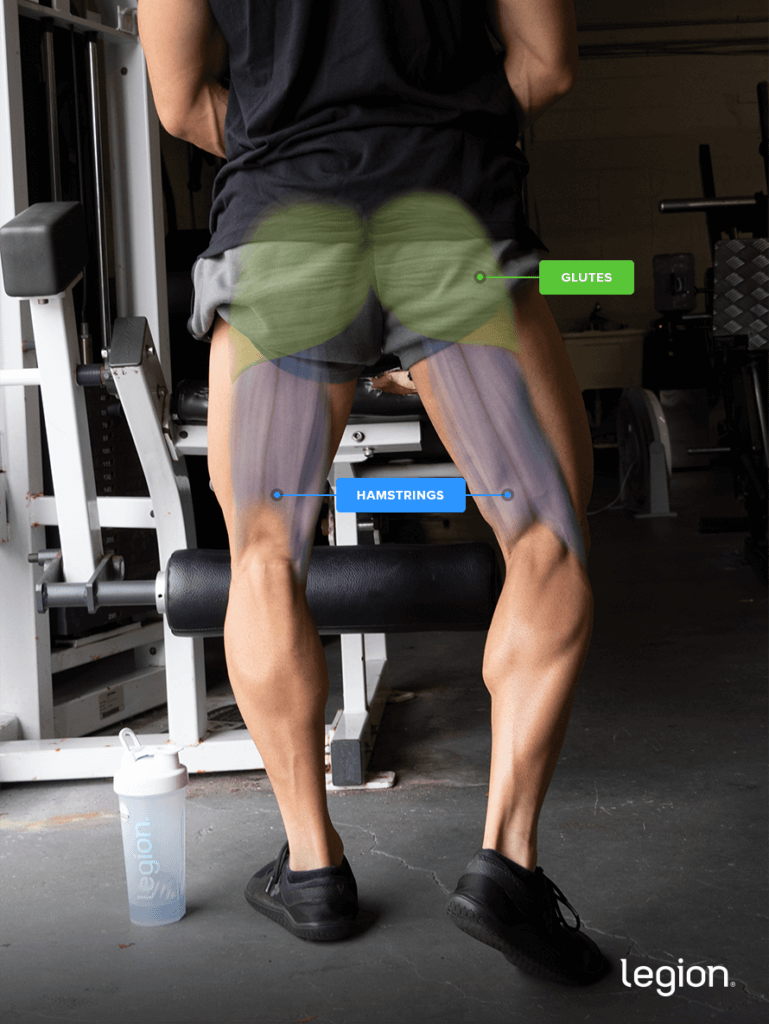
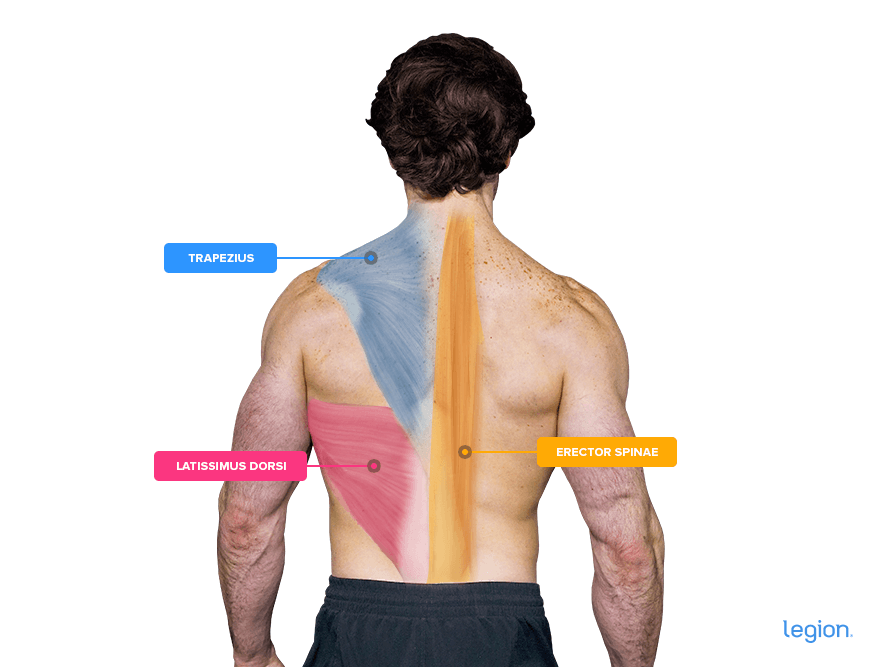
Romanian Deadlift: Benefits
1. It allows you to train your posterior chain without overreaching.
The main reason people do the Romanian deadlift is to train their hamstrings, glutes, and back without beating themselves up with too much conventional deadlifting.
Research shows the conventional deadlift is still the single best exercise for developing and strengthening all the major muscles in the posterior chain (the muscles on the back of your body).
It’s also extremely taxing on the body, though, which is why even advanced powerlifters rarely deadlift more than once per week and only do a few sets in each workout.
The Romanian deadlift is a compromise of sorts that lets you train many of the same muscles without risking overreaching or injury, which is why it’s an excellent exercise to include in your routine in addition to conventional deadlifting.
2. It trains your hamstrings eccentrically and in a stretched position.
There are two types of muscle action during most resistance exercises: Concentric and eccentric. Concentric actions involve shortening a muscle, like during the lifting portion of a biceps curl, and eccentric actions involve lengthening a muscle, like in the lowering portion of a biceps curl.
Research shows that exercises that emphasize the eccentric and train your muscles in a stretched position, like the Romanian deadlift, are highly effective for building muscle.
While scientists aren’t entirely sure why this is, their current best guess is that emphasizing the eccentric and placing your muscles under load when they’re stretched directly stimulates muscle protein synthesis and greatly increases anabolic (muscle-building) hormones.
3. It allows you to train your hamstring with heavy weights.
Generally speaking, the more weight you can lift, the more strength and muscle you can gain.
Unfortunately, most hamstring exercises—the conventional deadlift excepted—don’t allow you to handle heavy weights.
For example, exercises such as the hamstring curl, hyperextension, and kettlebell swing are all great exercises for training the hamstrings, but are all sorts of awkward with heavy weights.
The RDL, on the other hand, allows you to safely handle heavy weight and progress regularly, which means it’s ideal for building muscle and gaining strength.
Romanian Deadlift: Form
The best way to learn how to do the Romanian deadlift is to split the exercise into three parts: set up, descend, and lift.
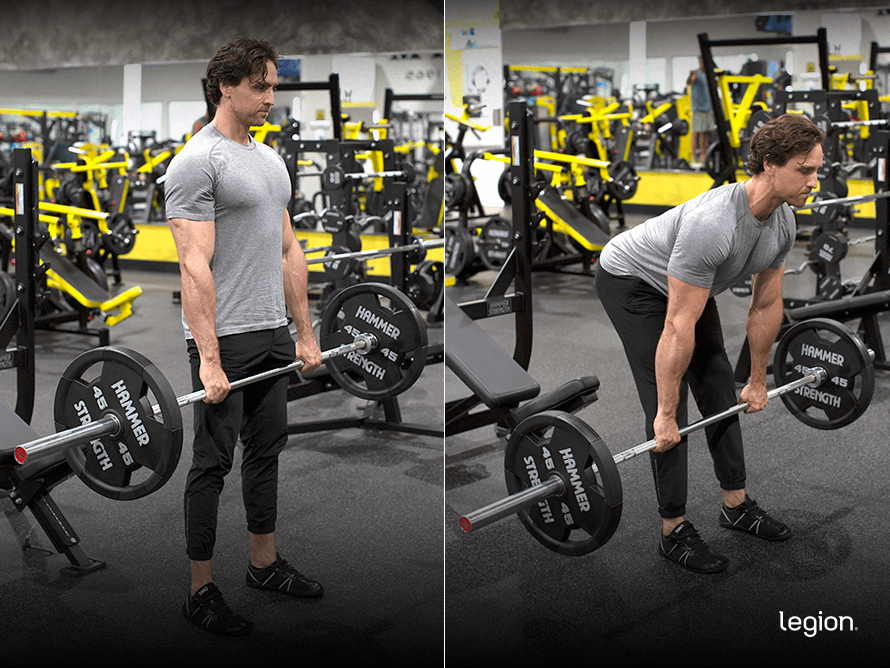
Step 1: Set Up
You can set up the Romanian deadlift in two ways: from a rack or from the floor.
Both are workable, but using a rack makes it easier to load the bar and prevents you wasting energy pulling the bar off the floor at the beginning of each set.
If you have a rack available, position a barbell in the rack at about the height of your mid-thigh.
If you set up from the floor, set up the same way you would for the conventional deadlift.
Walk up to the bar so that it’s over your midfoot and place your feet about shoulder-width apart, then grip the bar slightly outside of shoulder-width with your palms facing toward you.
Stand up straight holding the bar (if you’re using a rack, take a few steps backward so you’re clear of the rack), take a deep breath of air into your belly, raise your chest, and press your upper arms into your sides as if you were trying to crush oranges in your armpits.
Step 2: Descend
Flatten your back and lower the weights toward the floor in a straight line while keeping your legs mostly straight, allowing your butt to move backward as you descend.
Once you feel a stretch in your hamstrings, bend your knees slightly more, and continue lowering the weights until your lower back begins to round—just below the knees for most people, and about mid-shin for those who are particularly flexible.
Step 3: Lift
While keeping your back flat, chest up, and knees slightly bent, drive your hips forward while pulling the bar straight up and return to the starting position. This is a mirror image of what you did during the descent.
Here’s how it should look when you put it all together:
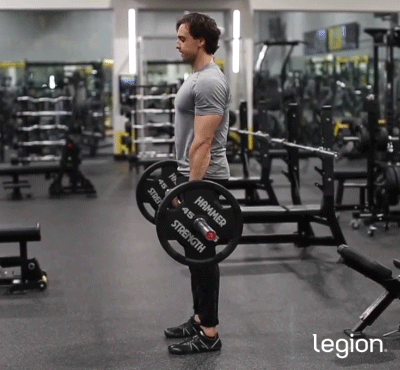
The Best Romanian Deadlift Workout
If you want to maximize muscle growth, research shows that it’s best to train your muscles in different ways, from different directions, and at different angles.
This is why it’s best to program the Romanian deadlift alongside other exercises that train your other lower-body muscles, like this:
- Barbell Back Squat: 3 sets of 4-to-6 reps with 2-to-3 min rest
- Romanian Deadlift: 3 sets of 4-to-6 reps with 2-to-3 min rest
- Leg Press: 3 sets of 8-to-10 reps with 2-to-3 min rest
- Seated Calf Raise: 3 sets of 8-to-10 reps with 2-to-3 min rest
The Best Romanian Deadlift Alternatives
1. Dumbbell Romanian Deadlift
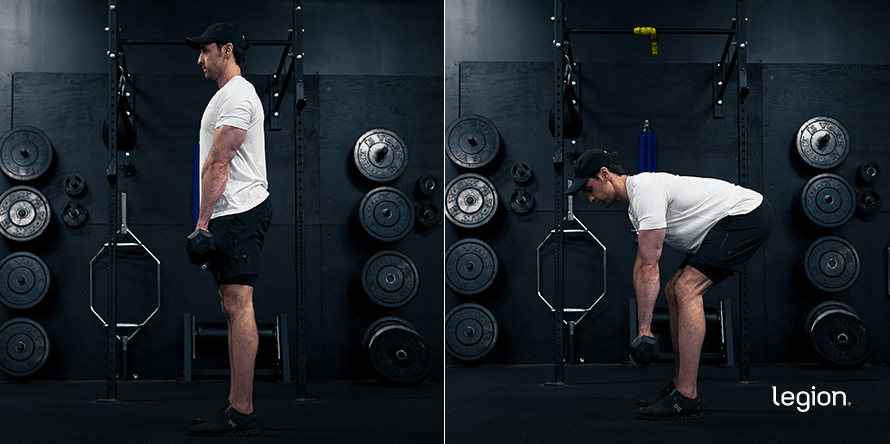
The Romanian deadlift with dumbbells (sometimes referred to as the “DB Romanian deadlift”) is exactly the same as the barbell Romanian deadlift, only instead of using a barbell you use dumbbells.
The benefit of the dumbbell Romanian deadlift is that it allows you to train through a longer range of motion. That’s because dumbbells tend to be smaller than the weight plates you use with a barbell, which means you can descend lower before the weights touch the floor.
That said, most people can lift more weight when they use a barbell, making the barbell variation slightly better for building muscle and gaining strength.
(Tip: If you don’t have access to dumbbells you can use kettlebells. The kettlebell Romanian deadlift trains your muscles in exactly the same way as the dumbbell Romanian deadlift—the only difference is you use kettlebells instead of dumbbells.)
2. Single-Leg Romanian Deadlift
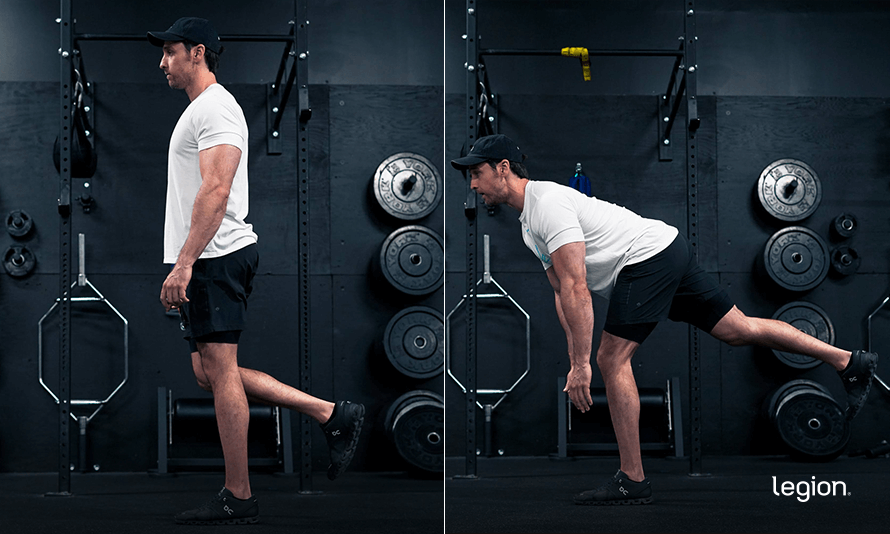
The single-leg Romanian deadlift, or “one-leg Romanian deadlift,” is the same as the regular Romanian deadlift, except you perform it using one leg at a time. You can also perform the single-leg Romanian deadlift with your body weight (pictured above), a pair of dumbbells (or kettlebells), or a band, rather than a barbell.
The main benefits of the single-leg Romanian deadlift are that it has a longer range of motion than the regular Romanian deadlift, which is generally better for muscle growth, and it trains each side of your body independently, which means it’s useful for identifying and evening out any strength or muscle imbalances you might have.
The downside, though, is that you can’t use nearly as much weight as you can with the regular Romanian deadlift, and maintaining your balance becomes harder as you get stronger.
This is why I recommend you stick to the traditional Romanian deadlift, and only use single-leg deadlift variations when you don’t have access to a barbell (when traveling, for example).
3. Banded Romanian Deadlift
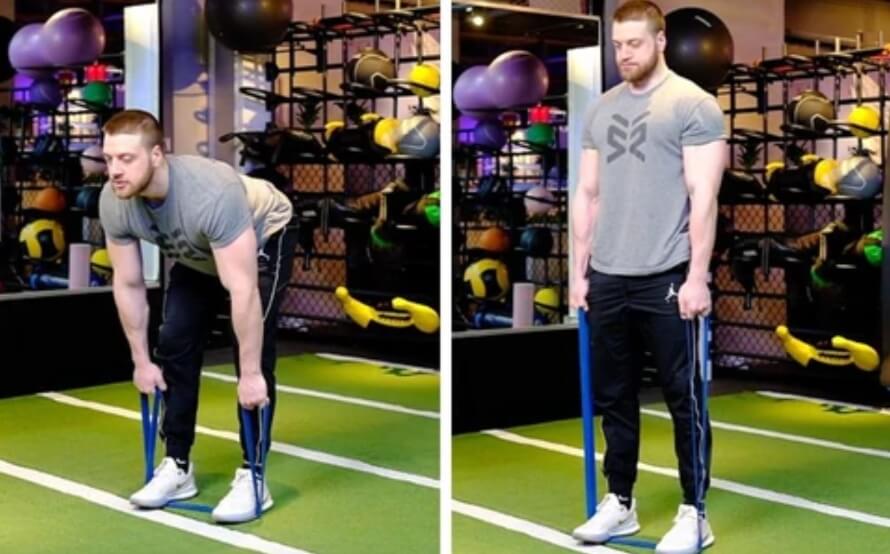
The banded Romanian deadlift is a good Romanian deadlift alternative if you like to work out at home or while traveling and have limited space and equipment.
However, the banded Romanian deadlift isn’t optimal for one reason: When you use a resistance band, you don’t place your muscles under much tension when they’re stretched. This makes the banded Romanian deadlift less effective for building muscle than the barbell and dumbbell variations, which is why you should only use it when you don’t have access to a barbell or dumbbells.
FAQ #1: Romanian deadlift vs. Stiff leg deadlift: Which is better?
The stiff-leg deadlift is almost identical to the Romanian deadlift except the bar starts and finishes each rep on the floor.
Research shows that the stiff-leg deadlift is a good deadlift variation for glute, hamstrings, and lower-back development because it has a long range of motion.
However, most people can’t lift as much weight using the stiff-leg deadlift as they can with the RDL, it can be uncomfortable if you don’t have good flexibility or if you have lower-back issues, and it can be difficult to learn. This is why most people prefer the Romanian deadlift to the stiff-leg deadlift, and why it’s the variation I recommend in my programs for men and women.
FAQ #2: Is the Romanian deadlift safe for your back?
Provided you use proper form, yes.
Research shows that the conventional deadlift (which involves a very similar movement to the Romanian deadlift) is perfectly safe and may even help to prevent lower-back injuries.
FAQ #3: Can you do the Romanian deadlift on the Smith machine?
Yes.
The Smith machine Romanian deadlift probably isn’t quite as effective at developing your lower-body muscles as the barbell Romanian deadlift, but it’s a workable Romanian deadlift alternative if you don’t have access to a barbell, you’re working around an injury, or you simply don’t want to do the barbell version.
+ Scientific References
- Lee, S., Schultz, J., Timgren, J., Staelgraeve, K., Miller, M., & Liu, Y. (2018). An electromyographic and kinetic comparison of conventional and Romanian deadlifts. Journal of Exercise Science & Fitness, 16(3), 87–93. https://doi.org/10.1016/J.JESF.2018.08.001
- Farthing, J. P., & Chilibeck, P. D. (2003). The effects of eccentric and concentric training at different velocities on muscle hypertrophy. European Journal of Applied Physiology, 89(6), 578–586. https://doi.org/10.1007/S00421-003-0842-2
- Friden, J., Seger, J., Sjostrom, M., & Ekblom, B. (1983). Adaptive response in human skeletal muscle subjected to prolonged eccentric training. International Journal of Sports Medicine, 4(3), 177–183. https://doi.org/10.1055/S-2008-1026031
- McMahon, G. E., Onambélé-Pearson, G. L., I. Morse, C., Burden, A. M., & Winwood, K. (2013). How Deep Should You Squat to Maximise a Holistic Training Response? Electromyographic, Energetic, Cardiovascular, Hypertrophic and Mechanical Evidence. Electrodiagnosis in New Frontiers of Clinical Research. https://doi.org/10.5772/56386
- Rindom, E., Kristensen, A. M., Overgaard, K., Vissing, K., & de Paoli, F. V. (2020). Estimation of p70S6K Thr389 and 4E-BP1 Thr37/46 phosphorylation support dependency of tension per se in a dose-response relationship for downstream mTORC1 signalling. Acta Physiologica, 229(1), e13426. https://doi.org/10.1111/APHA.13426
- Eliasson, J., Elfegoun, T., Nilsson, J., Köhnke, R., Ekblom, B., & Blomstrand, E. (2006). Maximal lengthening contractions increase p70 S6 kinase phosphorylation in human skeletal muscle in the absence of nutritional supply. American Journal of Physiology. Endocrinology and Metabolism, 291(6). https://doi.org/10.1152/AJPENDO.00141.2006
- Franchi, M. V., Atherton, P. J., Reeves, N. D., Flück, M., Williams, J., Mitchell, W. K., Selby, A., Beltran Valls, R. M., & Narici, M. V. (2014). Architectural, functional and molecular responses to concentric and eccentric loading in human skeletal muscle. Acta Physiologica (Oxford, England), 210(3), 642–654. https://doi.org/10.1111/APHA.12225
- Barakat, C., Barroso, R., Alvarez, M., Rauch, J., Miller, N., Bou-Sliman, A., & De Souza, E. O. (2019). The Effects of Varying Glenohumeral Joint Angle on Acute Volume Load, Muscle Activation, Swelling, and Echo-Intensity on the Biceps Brachii in Resistance-Trained Individuals. Sports (Basel, Switzerland), 7(9). https://doi.org/10.3390/SPORTS7090204
- Boone, T., Board, R., Astorino, T., Baker, J., Brock, S., Dalleck, L., Goulet, E., Gotshall, R., Hutchison, A., Knight-Maloney, M., Kravitz, L., Laskin, J., Lim, Y. A., Lowery, L., Marks, D., Mermier, C., Robergs, R., Vella, C., Wagner, D., … Serrão, J. C. (2013). Journal of Exercise Physiologyonline Volume 16 Number 3 Editor-in-Chief Electromyographic Activity of Lower Body Muscles during the Deadlift and Still-Legged Deadlift.
- Cholewicki, J., & McGill, S. M. (1992). Lumbar posterior ligament involvement during extremely heavy lifts estimated from fluoroscopic measurements. Journal of Biomechanics, 25(1), 17–28. https://doi.org/10.1016/0021-9290(92)90242-S
- Schwanbeck, S., Chilibeck, P. D., & Binsted, G. (2009). A comparison of free weight squat to Smith machine squat using electromyography. Journal of Strength and Conditioning Research, 23(9), 2588–2591. https://doi.org/10.1519/JSC.0B013E3181B1B181
[ad_2]
Source link

